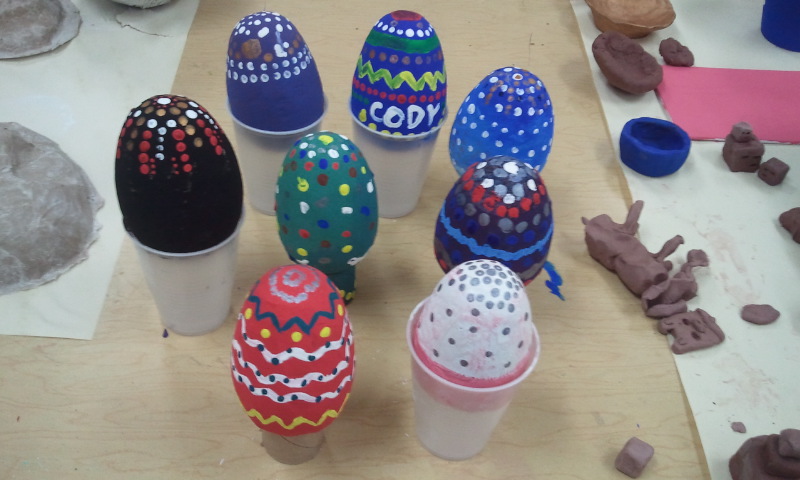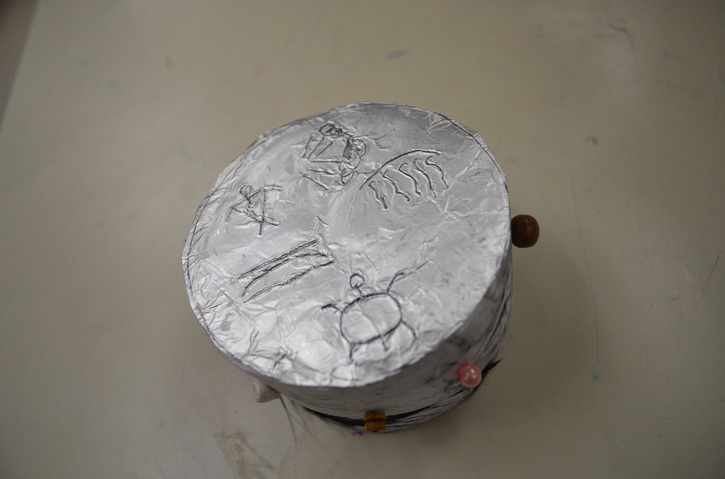|
Just had to share a photo of the crazy coil clay projects that are drying. These were made by 6th graders! I will post more details about the lesson when they are finished, but I just couldn't wait that long!
0 Comments
This has got to be one of my favorite projects to work on with my middle school art students. The project goes relatively quickly (2 class times) and my students love to learn about the glass artist Dale Chihuly. The sculpture in the picture above is made of 200 plastic bottles. Each bottle was donated by a student or staff member at our school. We started collecting bottles about 3 weeks before we started the project. Each student selected a bottle & painted it with acrylic. Acrylic paint works much better than tempera. Next, each student was assigned a style for cutting the bottle apart (star shape or spiral shape). Some students modified their styles slightly for a more unique design.
I decided to create two summer art classes that were each a week long through Community education in my district. The first class was called "Art Around the World" and featured projects such as a chinese lantern, making didgeridoos out of PVC pipe, and multicultural paper mache masks. The second class was called "Arts & Crafts Camp" and I definitely think this class was my favorite. The Arts & Crafts camp really let student's imaginations run wild and create some really cool art! Each class included students from the ages of 9 to 13. If you've never taught a community ed art class before, you should know it's a blast! No tests, no standards, just a room full of art supplies and enthusiastic students. For any other interested art teachers out there, I included the schedules for each class's days below for your reference. Art Around the World Day One- Mexican Folk Art terra cotta pots & Paper mache mask Day Two- Australian Didgeridoos made out of PVC pipe with a beeswax mouthpiece Day Three- African Adinkra printmaking on t-shirts Day Four- Ukrainian painted eggs & Russian architecture metal tooling Day Five- Chinese Calligraphy lantern & Free Art Time Arts & Crafts Camp Day One- Cardboard Challenge & Leather tooling/stamping Day Two- Travel Posters & Clay food Day Three- Dada-inspired lamp & Drawing to Music Day Four- Metal tooling & painting clay food to look realistic Day Five- Junk Sculptures & Hot glue fancy frames Check out the photos below to see all of the cool art we created & tips for doing the same! 
Metal tooled tiles. Cut 38 gauge aluminum metal into 6"x6" squares. The foil I purchased was from Dick Blick and came in 12"x25 ft rolls for around $16. Fold a 1/2" over on each side to prevent injury. Use a blunt pencil to tool designs. I had students draw their design on scratch paper first and then put their paper over the metal and traced to transfer. Use colored sharpie to highlight the areas you tooled. You can also turn the metal over for an embossed effect.

The lamps were created using pint size mason jars, socket light switch kit ($3.99 at Menards or other hardware store), modge podge, tacky glue, and an assortment of magazines and newspapers. Students decoupaged their cut outs onto the lamp using the tacky glue and modge podge. Some students used shredded up tissue paper and decoupaged the tissue paper to the inside of their lamp for a cool background. We used a nail to pound a hole into the lid and then used tin snips to cut a larger hole (this was mostly done by me due to sharp edges). Then the sock was inserted into the hole and a nightlight bulb placed inside that! The original project idea was for a hanging lamp, but some students designed their lamp to sit on a table. We simple cut a small notch in the lid for the cord, so the lamp could sit level. This was probably my student's favorite project!

A cool way to work on the didgeridoo was actually discovered by accident! We placed didgeridoos on sturdy, over-turned chair legs so we didn't have to worry about smearing paint. 1 1/2" schedule 40 PVC was used and cut in a variety of lengths from 3.5 ft to 5.5 ft. Students sanded the PVC and then painted at least two coats of acrylic paint onto the PVC. Next, students took q-tips and paint to create aboriginal-inspired dot paintings on their didgeridoo. The last step was adding melted beeswax to the top to create a mouthpiece and a few beads/feathers for decoration. This project was student's favorite from the Art Around the World class!
 The face pot lesson was a big hit! This lesson focused on so many different elements and techniques in using ceramics. Students learned about:
Videos created for this lesson . . .Well, my first glaze fire was a success! These Amaco F-series glazes sure are forgiving. We went through 10 bottles of glaze! Since we were so low on clay, my original plan for students to create a plate had to be sized down. Instead, I had students create a small 4-5" medallion and create a design using radial symmetry and texture. We looked at other Islamic tiles for inspiration and even took a virtual tour of the Blue Mosque in Turkey. The tour got a lot of enthusiasm! I gave students a choice on how they wanted to use their medallions. Some students chose to create a wind chime, others chose to make them into a necklace or to hang on the wall, and some students said they'd like to use their medallions as a coaster or candle holder. Some students even included Arabic writing in their designs!  Students also had one day to create a simple pinch pot with a face using addition (slipping & scoring method). I had students poke a hole in the bottom to turn them into mini flower pots. We are planting chia seeds in the pots when we come back from Spring Break. We'll let them grow in my window for a week, and then students get to take home a "living sculpture"!  Well the American Indian art unit is complete! We made birchbark boxes from cardstock paper with printed birchbark textures. I had students use beads, feathers, and leather scraps to decorate their boxes. Some students got a bit over-excited with the decorations, but some boxes turned out so cool! We did a compare/contrast between the artist Bobby Wilson and traditional Ojibwe art. We also did a graffiti write on what they knew already about Ojibwe art. In total, the unit took about 5 (50 min.) class periods in total for most students to finish. Some students really struggled with assembling their boxes, but most seemed to get it. One thing I added to this lesson was a tooled metal lid. I had students do some beginner metal tooling in heavy duty aluminum foil. Students were asked to tool with a blunt pencil at least three Ojibwe symbols into their aluminum foil. We cut and glued the foil to the paper lid. We also talked about the differences between traditional and contemporary Native American art. This led to a great discussion on how stereotypes can hurt people and what kind of stereotypes we all experience on a daily basis. It was pretty powerful, and overall, a fun project!  Our painted bottles waiting to dry Our painted bottles waiting to dry I have seen many art teachers attempt a Chihuly-inspired sculpture. This was a quick two-day project that had great results! We collected over 350 plastic bottles from students, parents, and staff over the semester. As a quick project before winter break, we made four Chihuly sculptures. Day One Students were introduced to the artist Dale Chihuly. We talked about the principles of design of form and movement. We looked at the Mayo Clinic's collection of Chihuly's art in the Gonda Building. Many students were excited about this because they had seen these in real life. We also talked about abstract art and what this meant. We had a short discussion about Chihuly and his team. I asked students if they thought Chihuly was a real artist if he has other people make his work. This created a great discussion/debate about the difference between an artist and a designer. Students then took a plastic bottle (some chose the same one from their drawing). I told students to choose a bottle that wasn't too thick. The really thin and cheap water bottles worked best. AVOID the gatorade, ICE, and thicker milk/juice bottles. I had students write their name on some masking tape and stick it to the bottom of their bottles. Students then used coarse sand paper to sand their bottles down. This helps the paint stick better. I used elmer's glue, neon paint, and a small bit of water to create the paint mixture. After students sanded, they immediately painted their bottles. I allowed students to use more than one color and they could also do a design like stripes or polka dots. I told students that it was okay if the paint was thicker in some places than others. Once they were painted, we left them standing up right in the cupboard to dry. Day Two We reviewed form, movement, and abstract art. I did a quick demo on how to the cut the bottle in either a spiral or flower design. I numbered students off 1-2. #1 did a spiral. #2 did a flower. Students cut the bottoms of their bottles off and then cut their design. I created wire cages with christmas lights in advance. I used string to hang the wire cage from the ceiling. We attached the bottles by tying with string/wire at the opening of the bottle and attaching to the wire cage. I did most of the tying to the cage as it got too chaotic to have all the students at once trying to attach their bottles. Some of the paint flaked off a bit, so we did quite a bit of sweeping. Students who finished early were required to clean up and help students who might have been a bit behind. Once we had them all attached, we lit it up and turned the lights off....there were A LOT of "oooohs" and "aaaaahs". The last part of class we watched a 15-minute Video on Chihuly Chandelier's and Towers and how the glass is blown. There were four chandelier's total (2 classes for each chandelier). I plan on giving one of the chandeliers to another interested art teacher and keeping one. The other two I am hoping we can raffle off at our end of the semester "classroom art show". I can just see these hanging up in a kid's room or outside on a deck (they are completely outdoors-proof). This was a lesson that EVERY student seemed to enjoy and was capable of doing. |
Mrs. QuamThis is my 11th year teaching art & graphic design! I have taught middle school for 2 years and high school for almost 5 years. I truly enjoy working with students on a daily basis. I also enjoy teaching real-world skills such as problem solving, using technology, and the power of teamwork and collaboration. My joy is sharing my passion for art with others! Archives
March 2024
Categories
All
|
Photo from Rob Qld


















































 RSS Feed
RSS Feed

